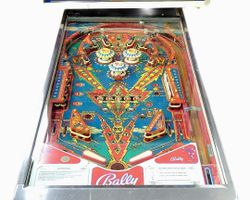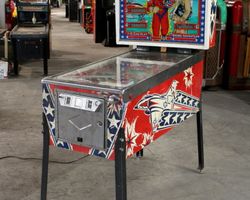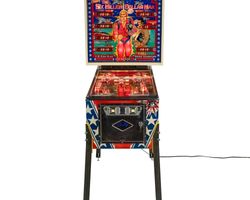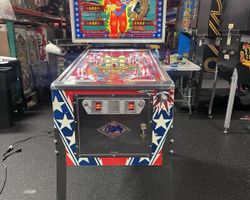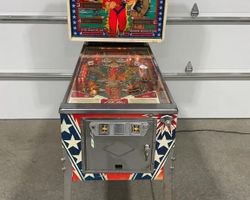The Six Million Dollar Man
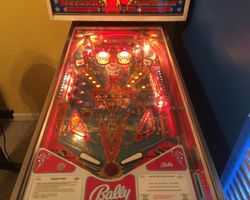
Average Prices: USD $200 to $2,100
Produced: October, 1978
Production Run: 10,320 units
Machine Type: Solid State Electronic
MPU: Bally MPU AS-2518-35
Players: 6
Design by: Greg Kmiec
Art by: Dave Christensen
Bally Manufacturing Corporation introduced The Six Million Dollar Man pinball machine in October 1978, drawing its theme directly from the popular television series. This solid-state electronic (SS) game emerged during a transitional period for Bally, aiming to capitalize on a well-known licensed property. With a production run of 10,320 units, it became a notable release of its era.
The machine's design was spearheaded by Greg Kmiec, known for his ability to craft engaging playfields. Dave Christensen, a celebrated artist, brought the visual elements to life, including the distinctive backglass and playfield artwork. The genesis of The Six Million Dollar Man involved an internal Bally whitewood project titled "City Slicker," a name Kmiec had adopted from a local clothing store. The gameplay characteristics of the "City Slicker" whitewood proved so compelling that it was selected to carry the newly acquired license for The Six Million Dollar Man. This decision extended the collaborative success previously seen between Kmiec and Christensen on earlier Bally titles. A unique design choice for The Six Million Dollar Man was its six-player capability. This was not merely a design whim but a strategic decision by Bally to exhaust their existing inventory of 6-digit score displays before fully transitioning to 7-digit displays in subsequent models. This practical consideration allowed for an expanded social play experience, a less common feature for solid-state machines at the time.
The production of The Six Million Dollar Man also served as a testing ground for various component changes. Bally was exploring alternatives to the traditional #44 bayonet bulbs due to the rising cost of brass in their bases. A pilot run of approximately 100 games incorporated #444 wedge bulbs and corresponding black plastic wedge sockets. These test games, identifiable by their factory-installed wedge sockets, were evaluated for brightness and reliability against the standard #44 bulb setup. While the #444 bulbs proved comparable, a later switch to the #555 wedge bulb, driven by further cost-saving initiatives from the purchasing department, led to significant issues. The initial batches of #555 bulbs proved defective, causing high failure rates in games, a problem that necessitated multiple production runs and various bead colors for identification before resolution. Furthermore, early production versions of the playfield for The Six Million Dollar Man featured a dark green background color, a subtle but distinct variation from the more commonly seen blue playfield.
Signature Features and Design
The Six Million Dollar Man incorporates several distinctive features that define its gameplay and aesthetic. A prominent element is the up-post positioned between the flippers. This strategically placed post can raise to save a draining ball, offering a reprieve and extending gameplay. The machine features two spinning targets, or spinners, which are integrated into scoring objectives and provide dynamic shot feedback. A single bank of five drop targets stands as a central playfield challenge, resetting upon completion and contributing to bonus accumulation.
Dave Christensen's artwork is a defining characteristic, particularly the backglass, which captures the theme's essence with a detailed depiction. The overall art package, while employing a patriotic palette of red, white, and blue, effectively conveys the sci-fi television show's atmosphere. The playfield design is balanced, offering a blend of open spaces for fast play and specific targets that demand precision. The solid-state MPU AS-2518-35 board powers the machine, providing responsive gameplay feedback and reliable operation, a hallmark of Bally's early solid-state era. These combined elements contribute to a machine that offers both mechanical engagement and visual appeal, enhancing the overall player experience.
Playfield and Mechanics
The playfield of The Six Million Dollar Man presents a straightforward yet engaging layout designed for a quick, action-oriented game. At the lower end, two flippers control ball trajectory. Above the flippers, two slingshots rebound the ball, adding unpredictability to the lower playfield. The central area is dominated by three pop bumpers, which provide high-scoring chaotic action as the ball caroms off them.
Key objectives are spread across the playfield. A central bank of five drop targets must be cleared to activate certain features and advance bonus scoring. Six standup targets are strategically placed, requiring accurate shots to light up various playfield features and contribute to the bonus multiplier. Two spinning targets provide satisfying visual and auditory feedback, adding to the scoring potential with sustained hits. The playfield also includes two star rollovers, often integral to lighting bonus features or advancing game progression. A kick-out hole typically serves as a collection point for special awards or bonus triggers. A right outlane ball return gate offers a chance to save a ball that would otherwise drain, adding a layer of strategic decision-making. The play-more post, an up-post situated between the flippers, stands ready to block a potential drain, offering a momentary reprieve and an opportunity to continue the ball in play, often at critical moments. The overall flow emphasizes continuous action, with shots designed to keep the ball in motion, encouraging players to adapt quickly to different playfield trajectories. The artwork, primarily in shades of red, white, and blue, provides a cohesive and visually striking environment that complements the machine's theme.
Gameplay Dynamics
The core gameplay of The Six Million Dollar Man revolves around accumulating a significant 50,000 bonus, which serves as the primary high-score objective. Players achieve this by systematically hitting the '5', '0', '0', '0', '0' rollovers and standup targets scattered across the playfield. Each successful hit contributes to lighting up the bonus value. Once the 50,000 bonus is fully lit, collecting it requires reaching a specific trigger, often the kick-out hole or a designated rollover.
Beyond the main bonus, the game rewards consistent flipper skills. The two spinning targets are a significant source of points, with prolonged hits dramatically increasing scores. Clearing the 5-bank drop targets offers a substantial reward and can activate bonus multipliers or other timed features. The interaction between the pop bumpers, slingshots, and targets creates a fast-paced environment where strategic nudging and precise flipper work are crucial. The up-post between the flippers, when active, can be a game-changer, preventing an immediate drain and granting the player a second chance to continue their score. The 6-player option facilitates competitive and social play, allowing multiple participants to engage in a high-score chase on the same machine, adding a dynamic layer for gatherings. While some objectives might appear straightforward, the combination of a quick playfield and unforgiving outlanes presents a consistent challenge, demanding player focus and skill to maximize scores and extend ball times.
Reception and Legacy
The Six Million Dollar Man generally holds a positive standing within the pinball community, often remembered for its fast action and solid design. Its association with the popular television show naturally fosters a sense of nostalgia for many players, contributing to its appeal and initial widespread adoption. Reviewers frequently commend the backglass artwork, particularly highlighting its detail and how effectively it captures the essence of the show. The overall art package is often described as vibrant and patriotic, resonating well with the themed content.
From a gameplay perspective, the machine is widely regarded as fast and enjoyable, particularly for an early solid-state title. The dual spinners and the challenging 5-bank drop targets are often cited as standout features that contribute to the game's addictive nature. The "play-more post" (the up-post between the flippers) is a frequently praised mechanic, offering a unique save opportunity that can significantly impact a game's outcome. The bonus countdown sequence at the end of a ball is also noted as an engaging element. Its robust design and relative ease of service are further positives, making it a desirable machine for collectors. The capability for six players is frequently highlighted as a strong point, enhancing its appeal for social gatherings and group play.
However, the machine is not without its criticisms. The sound effects are often described as repetitive and rudimentary, failing to fully complement the gameplay. Some find the cabinet art less appealing compared to the backglass. While generally considered fun, some players suggest the game's replayability can be limited due to what they perceive as a basic or less unique gameplay loop. The scoring, particularly the emphasis on the 50,000 bonus, is sometimes seen as unbalanced. The outlanes can be particularly unforgiving, leading to quick drains, which can frustrate players. Additionally, some opinions suggest that the integration of the television show's theme into the actual gameplay mechanics could have been more profound. The prevalent use of red, white, and blue in the art, while thematic, is occasionally considered overdone by some.
Despite these criticisms, The Six Million Dollar Man remains a significant machine. Its production run of over 10,000 units cemented its place as a commercially successful title for Bally during a crucial period of transition to solid-state technology. It represents a quintessential example of early Bally solid-state design, demonstrating the evolution of pinball mechanics and scoring systems of the late 1970s. The machine's place in the broader history of pinball is secured by its high production numbers and its role as a testing bed for manufacturing innovations, such as the attempted shift from bayonet to wedge-base bulbs. Its legacy is tied to its status as a playable classic, reflecting a specific era of licensed pinball machines that continue to be sought after by enthusiasts.
Sponsored Links
 Ebay Listings
Ebay Listings
 Auction Results
Auction Results
| Cost | Location | Date |
|---|---|---|
| USD $3,889 |  Florida, United States Florida, United States |
04 April, 2025 |
| EUR €1,950 |  Nordrhein-Westfalen, Germany Nordrhein-Westfalen, Germany |
04 September, 2024 |
| USD $500 |  Ohio, United States Ohio, United States |
03 August, 2024 |
| EUR €2,200 |  Nordrhein-Westfalen, Germany Nordrhein-Westfalen, Germany |
25 May, 2024 |
| AUD $5,000 |  Queensland, Australia Queensland, Australia |
30 April, 2024 |
| USD $1,100 |  Arizona, United States Arizona, United States |
23 April, 2024 |
| USD $1,800 |  Illinois, United States Illinois, United States |
21 April, 2024 |
| USD $1,800 |  Illinois, United States Illinois, United States |
18 April, 2024 |
| USD $950 |  Georgia, United States Georgia, United States |
06 April, 2024 |
| USD $3,095 |  Georgia, United States Georgia, United States |
12 December, 2023 |


Private Policy · Search Website · Contact Us
As an eBay Partner, we may earn a commission from qualifying purchases made through links on this site, at no additional cost to you.
All trademarks and copyrighted materials remain property of their respective owners. All other content copyright 2007 - 2026 Pinpedia.

